Corporate Accounting Assignment: Funding and Liabilities Analysis
VerifiedAdded on 2022/08/25
|20
|4391
|18
Report
AI Summary
This report provides a comprehensive analysis of corporate accounting practices, specifically focusing on the funding sources utilized by the Woolworths Group and the National Australia Bank (NAB) over a three-year period (2017-2019). The analysis includes a detailed examination of equity share capital, loans from financial institutions, finance leases, and debt instruments. The report categorizes funding sources as internal and external, calculating the percentage of each for both companies, and discussing the advantages and disadvantages of each source. It also addresses the key provisions of AASB 137 regarding provisions, contingent liabilities, and contingent assets, identifying if the companies have referenced this standard in their annual reports. Finally, the report identifies different asset categories recorded by the companies and examines the measurement methods used, such as historical cost and fair value, for each class of assets. The report aims to develop a clear understanding of different sources of funds used by companies, their evolution, and the measurement basis for assets.
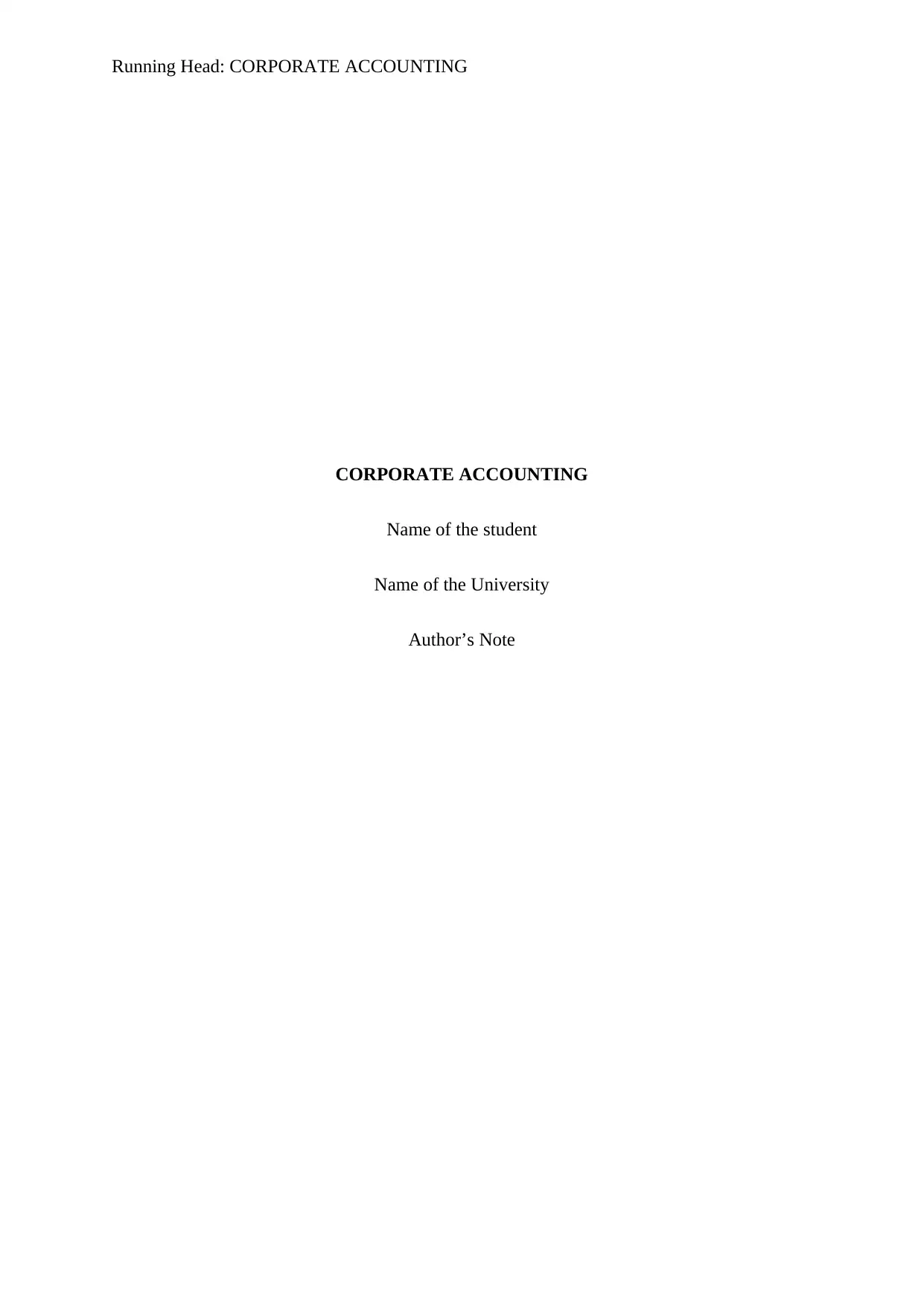
Running Head: CORPORATE ACCOUNTING
CORPORATE ACCOUNTING
Name of the student
Name of the University
Author’s Note
CORPORATE ACCOUNTING
Name of the student
Name of the University
Author’s Note
Paraphrase This Document
Need a fresh take? Get an instant paraphrase of this document with our AI Paraphraser
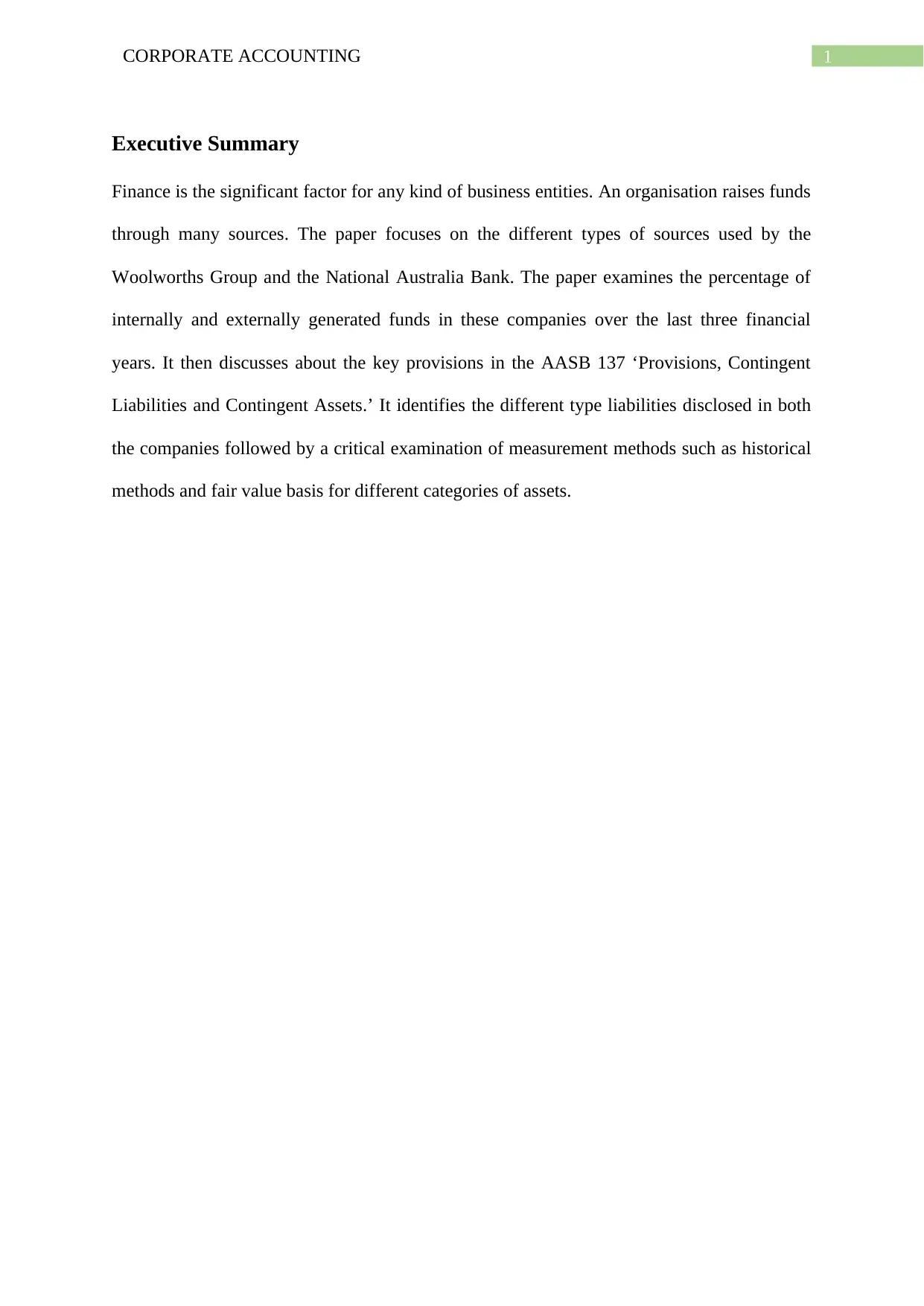
1CORPORATE ACCOUNTING
Executive Summary
Finance is the significant factor for any kind of business entities. An organisation raises funds
through many sources. The paper focuses on the different types of sources used by the
Woolworths Group and the National Australia Bank. The paper examines the percentage of
internally and externally generated funds in these companies over the last three financial
years. It then discusses about the key provisions in the AASB 137 ‘Provisions, Contingent
Liabilities and Contingent Assets.’ It identifies the different type liabilities disclosed in both
the companies followed by a critical examination of measurement methods such as historical
methods and fair value basis for different categories of assets.
Executive Summary
Finance is the significant factor for any kind of business entities. An organisation raises funds
through many sources. The paper focuses on the different types of sources used by the
Woolworths Group and the National Australia Bank. The paper examines the percentage of
internally and externally generated funds in these companies over the last three financial
years. It then discusses about the key provisions in the AASB 137 ‘Provisions, Contingent
Liabilities and Contingent Assets.’ It identifies the different type liabilities disclosed in both
the companies followed by a critical examination of measurement methods such as historical
methods and fair value basis for different categories of assets.
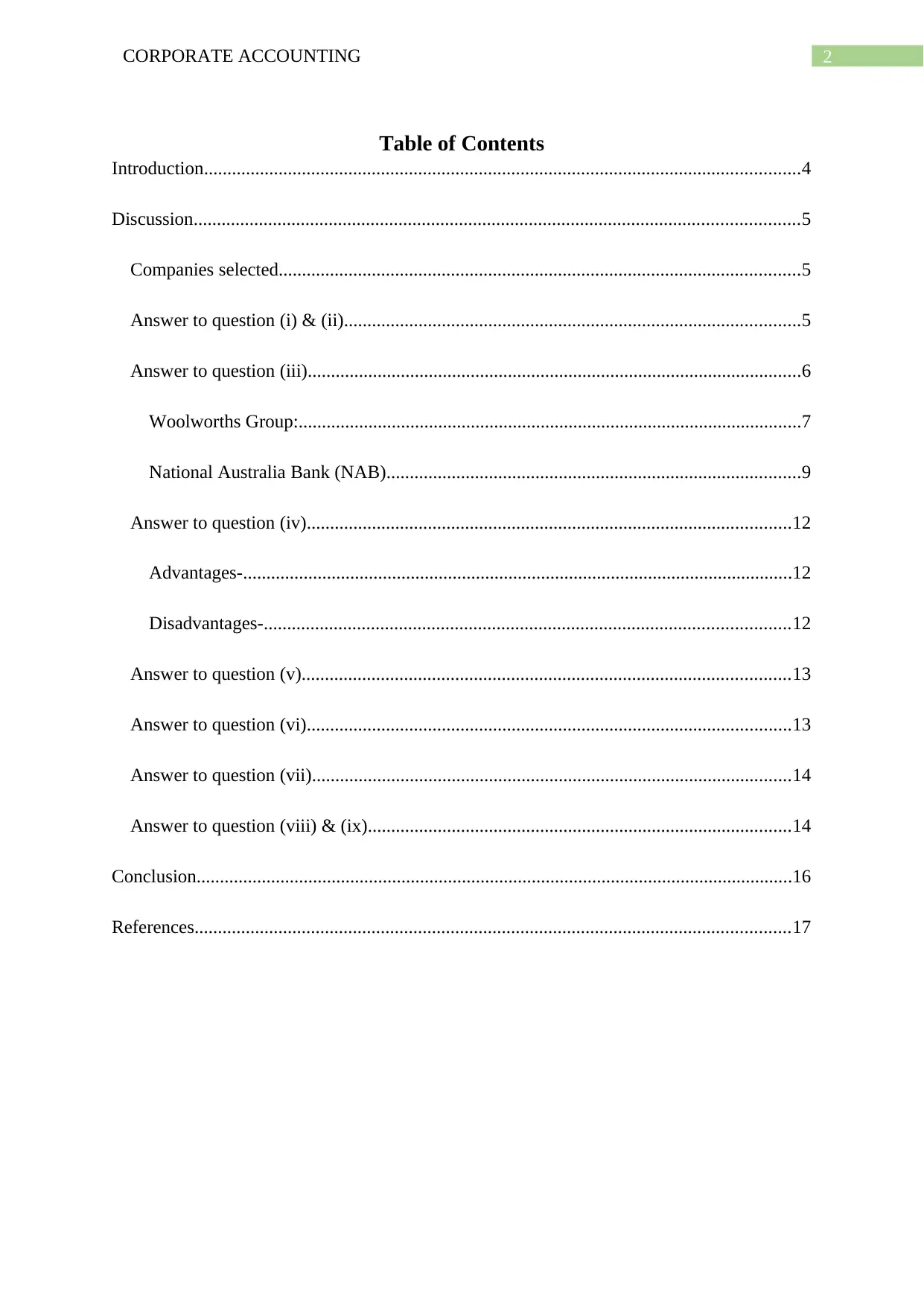
2CORPORATE ACCOUNTING
Table of Contents
Introduction................................................................................................................................4
Discussion..................................................................................................................................5
Companies selected................................................................................................................5
Answer to question (i) & (ii)..................................................................................................5
Answer to question (iii)..........................................................................................................6
Woolworths Group:............................................................................................................7
National Australia Bank (NAB).........................................................................................9
Answer to question (iv)........................................................................................................12
Advantages-......................................................................................................................12
Disadvantages-.................................................................................................................12
Answer to question (v).........................................................................................................13
Answer to question (vi)........................................................................................................13
Answer to question (vii).......................................................................................................14
Answer to question (viii) & (ix)...........................................................................................14
Conclusion................................................................................................................................16
References................................................................................................................................17
Table of Contents
Introduction................................................................................................................................4
Discussion..................................................................................................................................5
Companies selected................................................................................................................5
Answer to question (i) & (ii)..................................................................................................5
Answer to question (iii)..........................................................................................................6
Woolworths Group:............................................................................................................7
National Australia Bank (NAB).........................................................................................9
Answer to question (iv)........................................................................................................12
Advantages-......................................................................................................................12
Disadvantages-.................................................................................................................12
Answer to question (v).........................................................................................................13
Answer to question (vi)........................................................................................................13
Answer to question (vii).......................................................................................................14
Answer to question (viii) & (ix)...........................................................................................14
Conclusion................................................................................................................................16
References................................................................................................................................17
⊘ This is a preview!⊘
Do you want full access?
Subscribe today to unlock all pages.

Trusted by 1+ million students worldwide
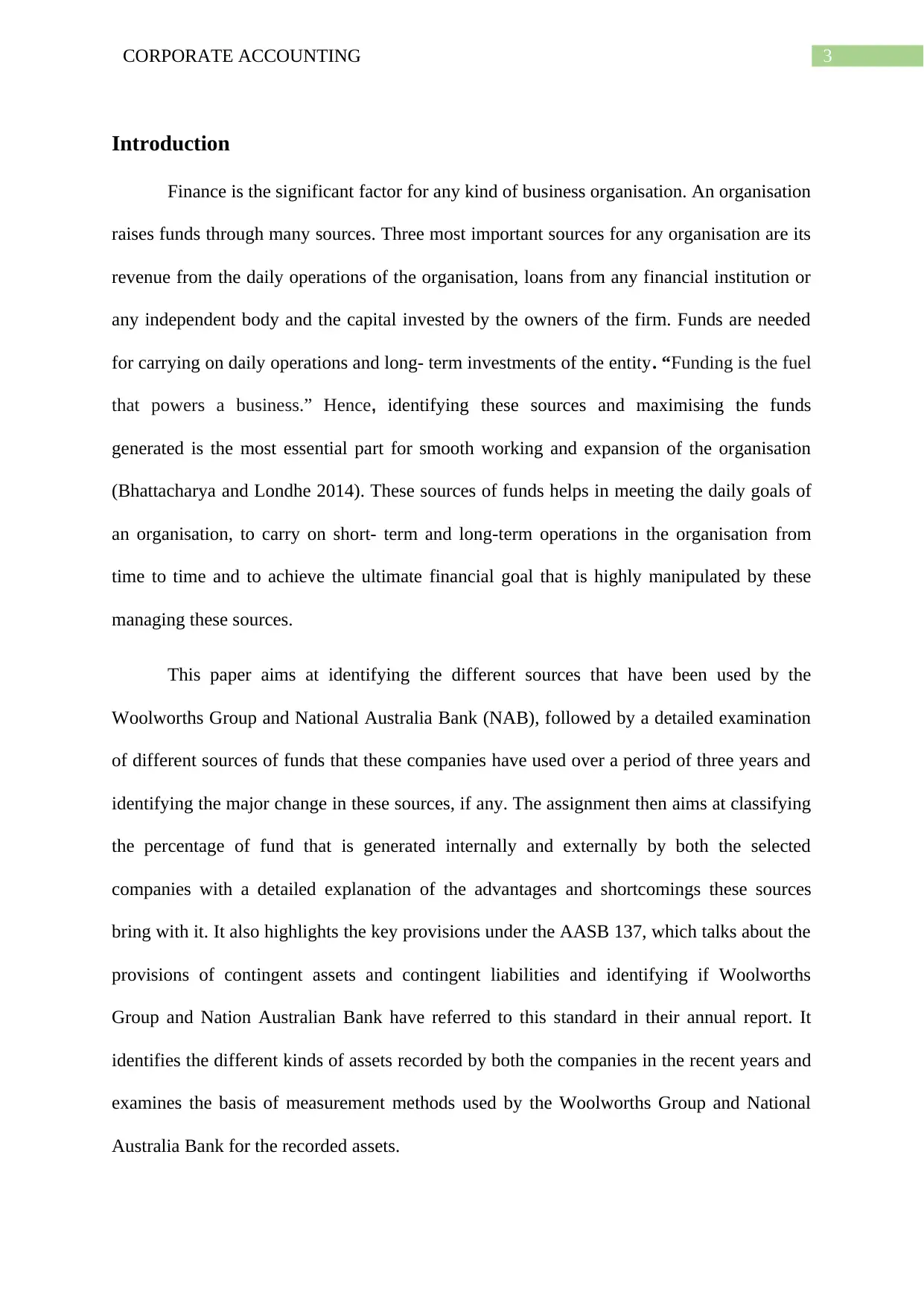
3CORPORATE ACCOUNTING
Introduction
Finance is the significant factor for any kind of business organisation. An organisation
raises funds through many sources. Three most important sources for any organisation are its
revenue from the daily operations of the organisation, loans from any financial institution or
any independent body and the capital invested by the owners of the firm. Funds are needed
for carrying on daily operations and long- term investments of the entity. “Funding is the fuel
that powers a business.” Hence, identifying these sources and maximising the funds
generated is the most essential part for smooth working and expansion of the organisation
(Bhattacharya and Londhe 2014). These sources of funds helps in meeting the daily goals of
an organisation, to carry on short- term and long-term operations in the organisation from
time to time and to achieve the ultimate financial goal that is highly manipulated by these
managing these sources.
This paper aims at identifying the different sources that have been used by the
Woolworths Group and National Australia Bank (NAB), followed by a detailed examination
of different sources of funds that these companies have used over a period of three years and
identifying the major change in these sources, if any. The assignment then aims at classifying
the percentage of fund that is generated internally and externally by both the selected
companies with a detailed explanation of the advantages and shortcomings these sources
bring with it. It also highlights the key provisions under the AASB 137, which talks about the
provisions of contingent assets and contingent liabilities and identifying if Woolworths
Group and Nation Australian Bank have referred to this standard in their annual report. It
identifies the different kinds of assets recorded by both the companies in the recent years and
examines the basis of measurement methods used by the Woolworths Group and National
Australia Bank for the recorded assets.
Introduction
Finance is the significant factor for any kind of business organisation. An organisation
raises funds through many sources. Three most important sources for any organisation are its
revenue from the daily operations of the organisation, loans from any financial institution or
any independent body and the capital invested by the owners of the firm. Funds are needed
for carrying on daily operations and long- term investments of the entity. “Funding is the fuel
that powers a business.” Hence, identifying these sources and maximising the funds
generated is the most essential part for smooth working and expansion of the organisation
(Bhattacharya and Londhe 2014). These sources of funds helps in meeting the daily goals of
an organisation, to carry on short- term and long-term operations in the organisation from
time to time and to achieve the ultimate financial goal that is highly manipulated by these
managing these sources.
This paper aims at identifying the different sources that have been used by the
Woolworths Group and National Australia Bank (NAB), followed by a detailed examination
of different sources of funds that these companies have used over a period of three years and
identifying the major change in these sources, if any. The assignment then aims at classifying
the percentage of fund that is generated internally and externally by both the selected
companies with a detailed explanation of the advantages and shortcomings these sources
bring with it. It also highlights the key provisions under the AASB 137, which talks about the
provisions of contingent assets and contingent liabilities and identifying if Woolworths
Group and Nation Australian Bank have referred to this standard in their annual report. It
identifies the different kinds of assets recorded by both the companies in the recent years and
examines the basis of measurement methods used by the Woolworths Group and National
Australia Bank for the recorded assets.
Paraphrase This Document
Need a fresh take? Get an instant paraphrase of this document with our AI Paraphraser
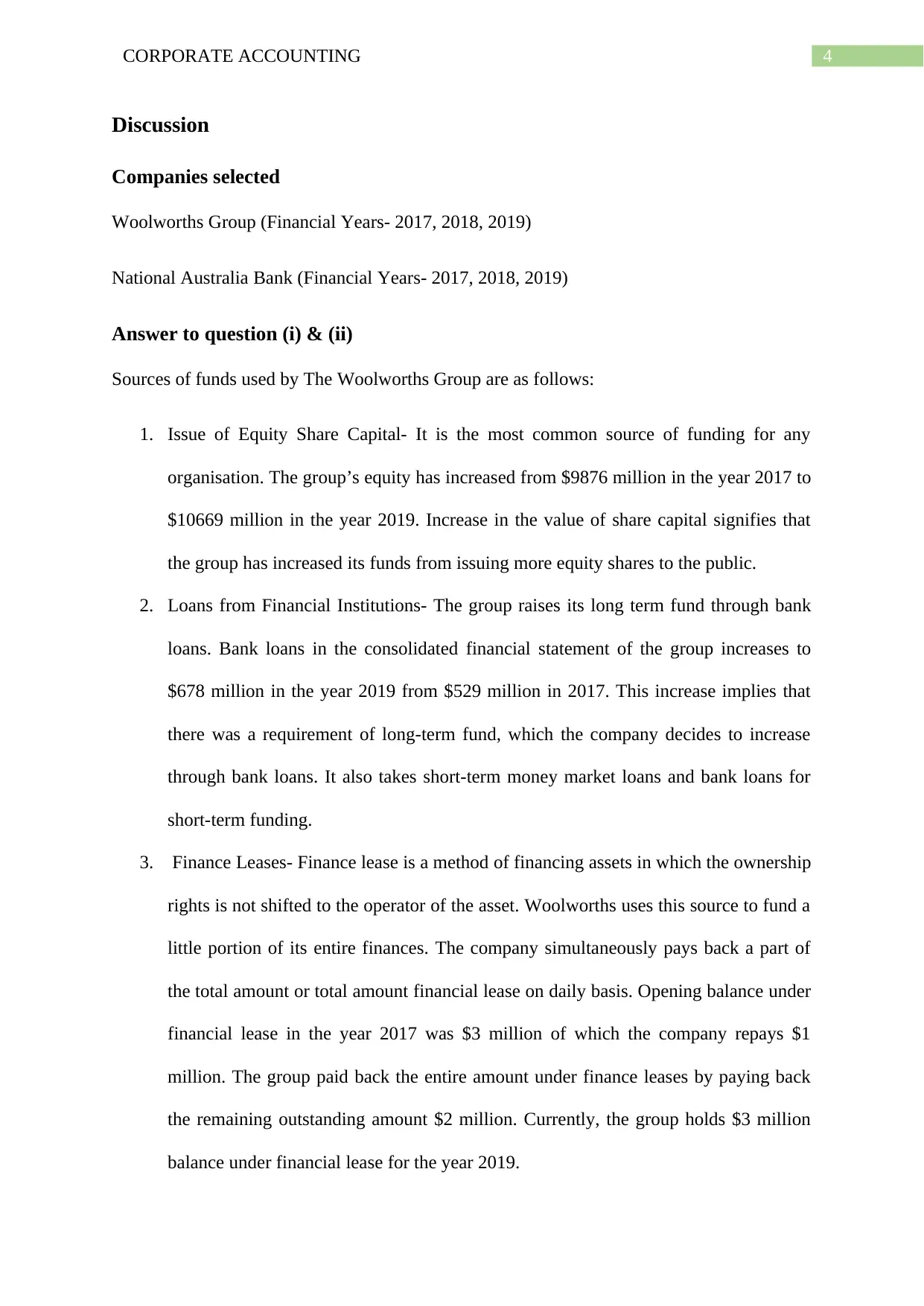
4CORPORATE ACCOUNTING
Discussion
Companies selected
Woolworths Group (Financial Years- 2017, 2018, 2019)
National Australia Bank (Financial Years- 2017, 2018, 2019)
Answer to question (i) & (ii)
Sources of funds used by The Woolworths Group are as follows:
1. Issue of Equity Share Capital- It is the most common source of funding for any
organisation. The group’s equity has increased from $9876 million in the year 2017 to
$10669 million in the year 2019. Increase in the value of share capital signifies that
the group has increased its funds from issuing more equity shares to the public.
2. Loans from Financial Institutions- The group raises its long term fund through bank
loans. Bank loans in the consolidated financial statement of the group increases to
$678 million in the year 2019 from $529 million in 2017. This increase implies that
there was a requirement of long-term fund, which the company decides to increase
through bank loans. It also takes short-term money market loans and bank loans for
short-term funding.
3. Finance Leases- Finance lease is a method of financing assets in which the ownership
rights is not shifted to the operator of the asset. Woolworths uses this source to fund a
little portion of its entire finances. The company simultaneously pays back a part of
the total amount or total amount financial lease on daily basis. Opening balance under
financial lease in the year 2017 was $3 million of which the company repays $1
million. The group paid back the entire amount under finance leases by paying back
the remaining outstanding amount $2 million. Currently, the group holds $3 million
balance under financial lease for the year 2019.
Discussion
Companies selected
Woolworths Group (Financial Years- 2017, 2018, 2019)
National Australia Bank (Financial Years- 2017, 2018, 2019)
Answer to question (i) & (ii)
Sources of funds used by The Woolworths Group are as follows:
1. Issue of Equity Share Capital- It is the most common source of funding for any
organisation. The group’s equity has increased from $9876 million in the year 2017 to
$10669 million in the year 2019. Increase in the value of share capital signifies that
the group has increased its funds from issuing more equity shares to the public.
2. Loans from Financial Institutions- The group raises its long term fund through bank
loans. Bank loans in the consolidated financial statement of the group increases to
$678 million in the year 2019 from $529 million in 2017. This increase implies that
there was a requirement of long-term fund, which the company decides to increase
through bank loans. It also takes short-term money market loans and bank loans for
short-term funding.
3. Finance Leases- Finance lease is a method of financing assets in which the ownership
rights is not shifted to the operator of the asset. Woolworths uses this source to fund a
little portion of its entire finances. The company simultaneously pays back a part of
the total amount or total amount financial lease on daily basis. Opening balance under
financial lease in the year 2017 was $3 million of which the company repays $1
million. The group paid back the entire amount under finance leases by paying back
the remaining outstanding amount $2 million. Currently, the group holds $3 million
balance under financial lease for the year 2019.
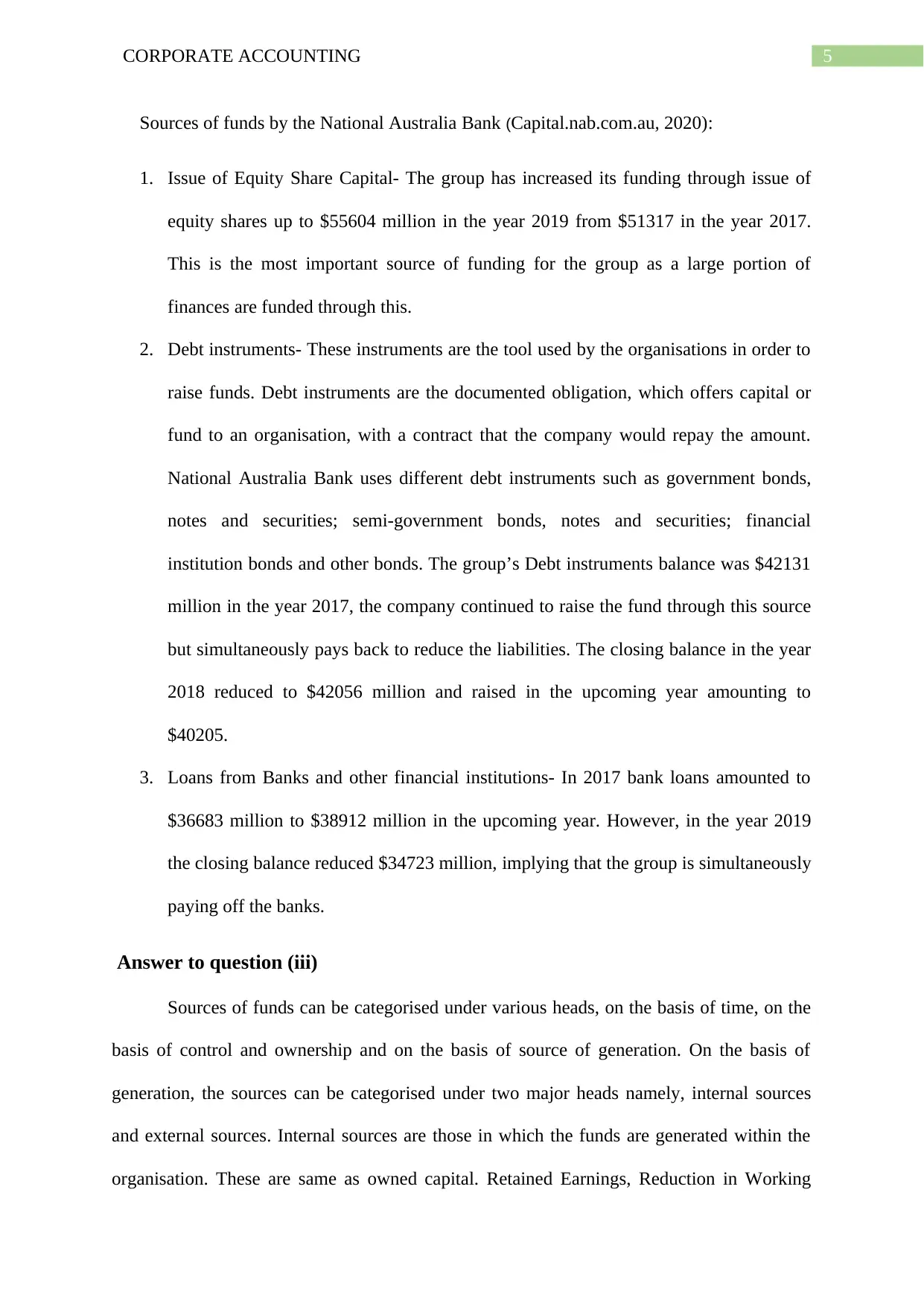
5CORPORATE ACCOUNTING
Sources of funds by the National Australia Bank (Capital.nab.com.au, 2020):
1. Issue of Equity Share Capital- The group has increased its funding through issue of
equity shares up to $55604 million in the year 2019 from $51317 in the year 2017.
This is the most important source of funding for the group as a large portion of
finances are funded through this.
2. Debt instruments- These instruments are the tool used by the organisations in order to
raise funds. Debt instruments are the documented obligation, which offers capital or
fund to an organisation, with a contract that the company would repay the amount.
National Australia Bank uses different debt instruments such as government bonds,
notes and securities; semi-government bonds, notes and securities; financial
institution bonds and other bonds. The group’s Debt instruments balance was $42131
million in the year 2017, the company continued to raise the fund through this source
but simultaneously pays back to reduce the liabilities. The closing balance in the year
2018 reduced to $42056 million and raised in the upcoming year amounting to
$40205.
3. Loans from Banks and other financial institutions- In 2017 bank loans amounted to
$36683 million to $38912 million in the upcoming year. However, in the year 2019
the closing balance reduced $34723 million, implying that the group is simultaneously
paying off the banks.
Answer to question (iii)
Sources of funds can be categorised under various heads, on the basis of time, on the
basis of control and ownership and on the basis of source of generation. On the basis of
generation, the sources can be categorised under two major heads namely, internal sources
and external sources. Internal sources are those in which the funds are generated within the
organisation. These are same as owned capital. Retained Earnings, Reduction in Working
Sources of funds by the National Australia Bank (Capital.nab.com.au, 2020):
1. Issue of Equity Share Capital- The group has increased its funding through issue of
equity shares up to $55604 million in the year 2019 from $51317 in the year 2017.
This is the most important source of funding for the group as a large portion of
finances are funded through this.
2. Debt instruments- These instruments are the tool used by the organisations in order to
raise funds. Debt instruments are the documented obligation, which offers capital or
fund to an organisation, with a contract that the company would repay the amount.
National Australia Bank uses different debt instruments such as government bonds,
notes and securities; semi-government bonds, notes and securities; financial
institution bonds and other bonds. The group’s Debt instruments balance was $42131
million in the year 2017, the company continued to raise the fund through this source
but simultaneously pays back to reduce the liabilities. The closing balance in the year
2018 reduced to $42056 million and raised in the upcoming year amounting to
$40205.
3. Loans from Banks and other financial institutions- In 2017 bank loans amounted to
$36683 million to $38912 million in the upcoming year. However, in the year 2019
the closing balance reduced $34723 million, implying that the group is simultaneously
paying off the banks.
Answer to question (iii)
Sources of funds can be categorised under various heads, on the basis of time, on the
basis of control and ownership and on the basis of source of generation. On the basis of
generation, the sources can be categorised under two major heads namely, internal sources
and external sources. Internal sources are those in which the funds are generated within the
organisation. These are same as owned capital. Retained Earnings, Reduction in Working
⊘ This is a preview!⊘
Do you want full access?
Subscribe today to unlock all pages.

Trusted by 1+ million students worldwide
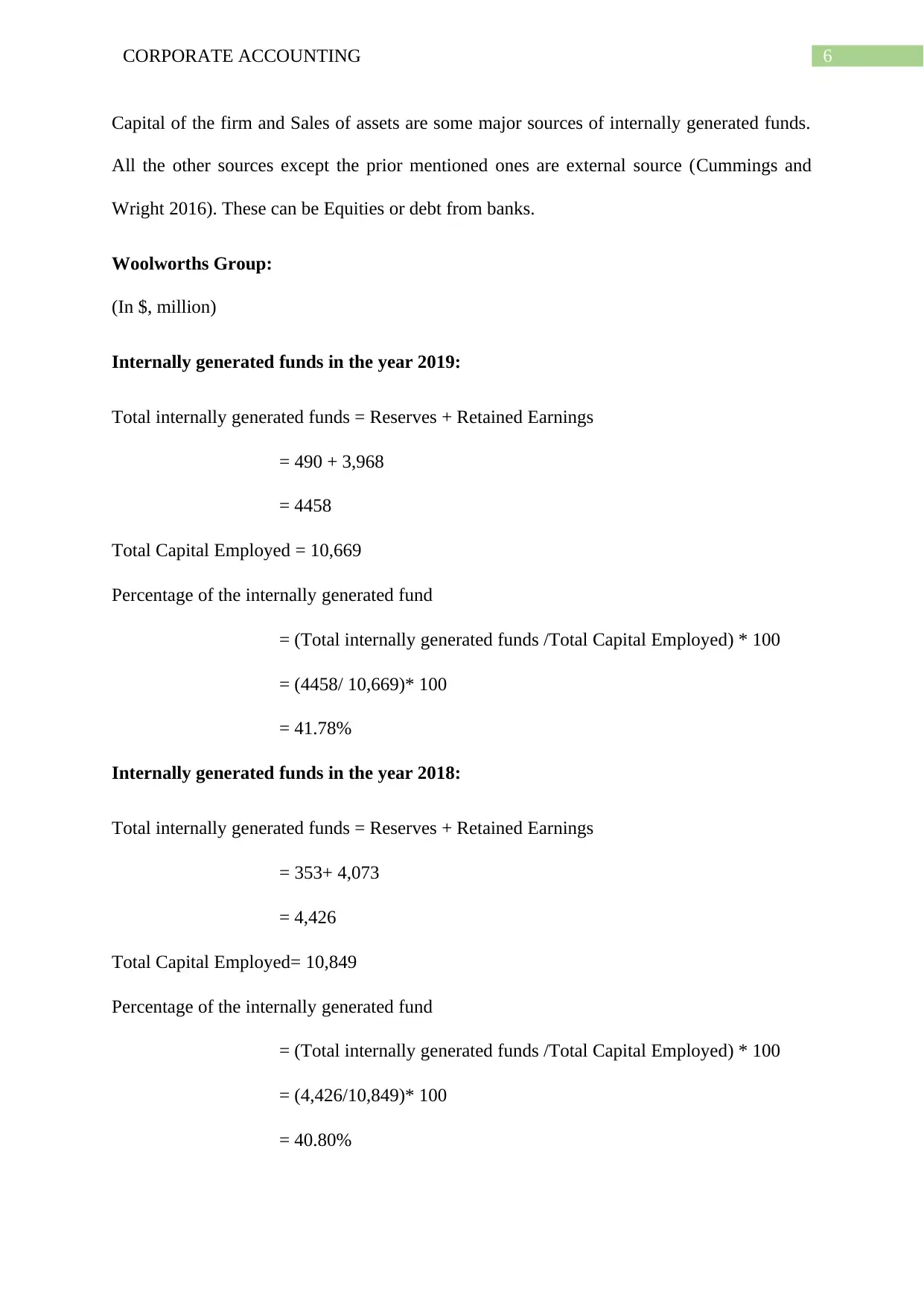
6CORPORATE ACCOUNTING
Capital of the firm and Sales of assets are some major sources of internally generated funds.
All the other sources except the prior mentioned ones are external source (Cummings and
Wright 2016). These can be Equities or debt from banks.
Woolworths Group:
(In $, million)
Internally generated funds in the year 2019:
Total internally generated funds = Reserves + Retained Earnings
= 490 + 3,968
= 4458
Total Capital Employed = 10,669
Percentage of the internally generated fund
= (Total internally generated funds /Total Capital Employed) * 100
= (4458/ 10,669)* 100
= 41.78%
Internally generated funds in the year 2018:
Total internally generated funds = Reserves + Retained Earnings
= 353+ 4,073
= 4,426
Total Capital Employed= 10,849
Percentage of the internally generated fund
= (Total internally generated funds /Total Capital Employed) * 100
= (4,426/10,849)* 100
= 40.80%
Capital of the firm and Sales of assets are some major sources of internally generated funds.
All the other sources except the prior mentioned ones are external source (Cummings and
Wright 2016). These can be Equities or debt from banks.
Woolworths Group:
(In $, million)
Internally generated funds in the year 2019:
Total internally generated funds = Reserves + Retained Earnings
= 490 + 3,968
= 4458
Total Capital Employed = 10,669
Percentage of the internally generated fund
= (Total internally generated funds /Total Capital Employed) * 100
= (4458/ 10,669)* 100
= 41.78%
Internally generated funds in the year 2018:
Total internally generated funds = Reserves + Retained Earnings
= 353+ 4,073
= 4,426
Total Capital Employed= 10,849
Percentage of the internally generated fund
= (Total internally generated funds /Total Capital Employed) * 100
= (4,426/10,849)* 100
= 40.80%
Paraphrase This Document
Need a fresh take? Get an instant paraphrase of this document with our AI Paraphraser
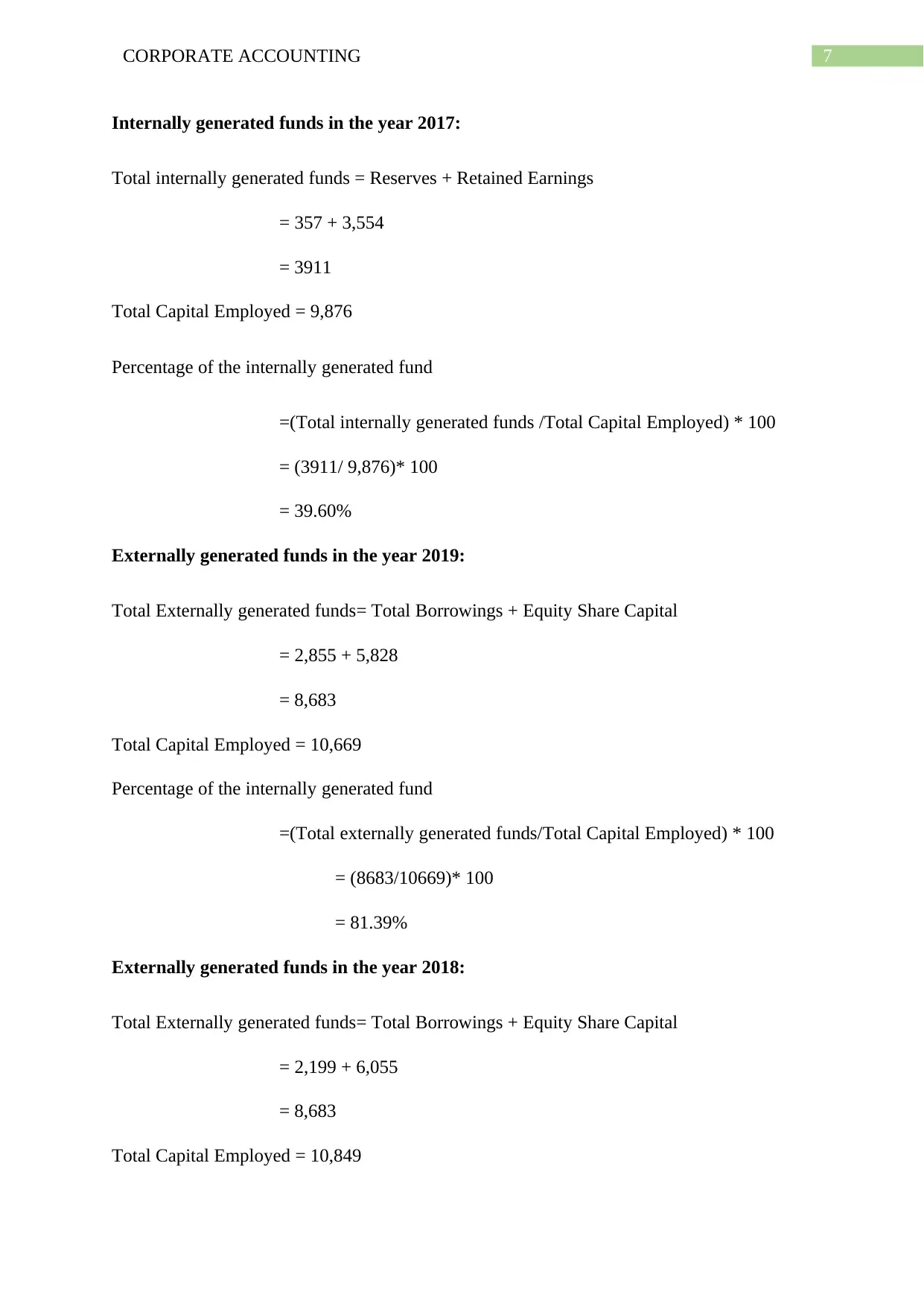
7CORPORATE ACCOUNTING
Internally generated funds in the year 2017:
Total internally generated funds = Reserves + Retained Earnings
= 357 + 3,554
= 3911
Total Capital Employed = 9,876
Percentage of the internally generated fund
=(Total internally generated funds /Total Capital Employed) * 100
= (3911/ 9,876)* 100
= 39.60%
Externally generated funds in the year 2019:
Total Externally generated funds= Total Borrowings + Equity Share Capital
= 2,855 + 5,828
= 8,683
Total Capital Employed = 10,669
Percentage of the internally generated fund
=(Total externally generated funds/Total Capital Employed) * 100
= (8683/10669)* 100
= 81.39%
Externally generated funds in the year 2018:
Total Externally generated funds= Total Borrowings + Equity Share Capital
= 2,199 + 6,055
= 8,683
Total Capital Employed = 10,849
Internally generated funds in the year 2017:
Total internally generated funds = Reserves + Retained Earnings
= 357 + 3,554
= 3911
Total Capital Employed = 9,876
Percentage of the internally generated fund
=(Total internally generated funds /Total Capital Employed) * 100
= (3911/ 9,876)* 100
= 39.60%
Externally generated funds in the year 2019:
Total Externally generated funds= Total Borrowings + Equity Share Capital
= 2,855 + 5,828
= 8,683
Total Capital Employed = 10,669
Percentage of the internally generated fund
=(Total externally generated funds/Total Capital Employed) * 100
= (8683/10669)* 100
= 81.39%
Externally generated funds in the year 2018:
Total Externally generated funds= Total Borrowings + Equity Share Capital
= 2,199 + 6,055
= 8,683
Total Capital Employed = 10,849
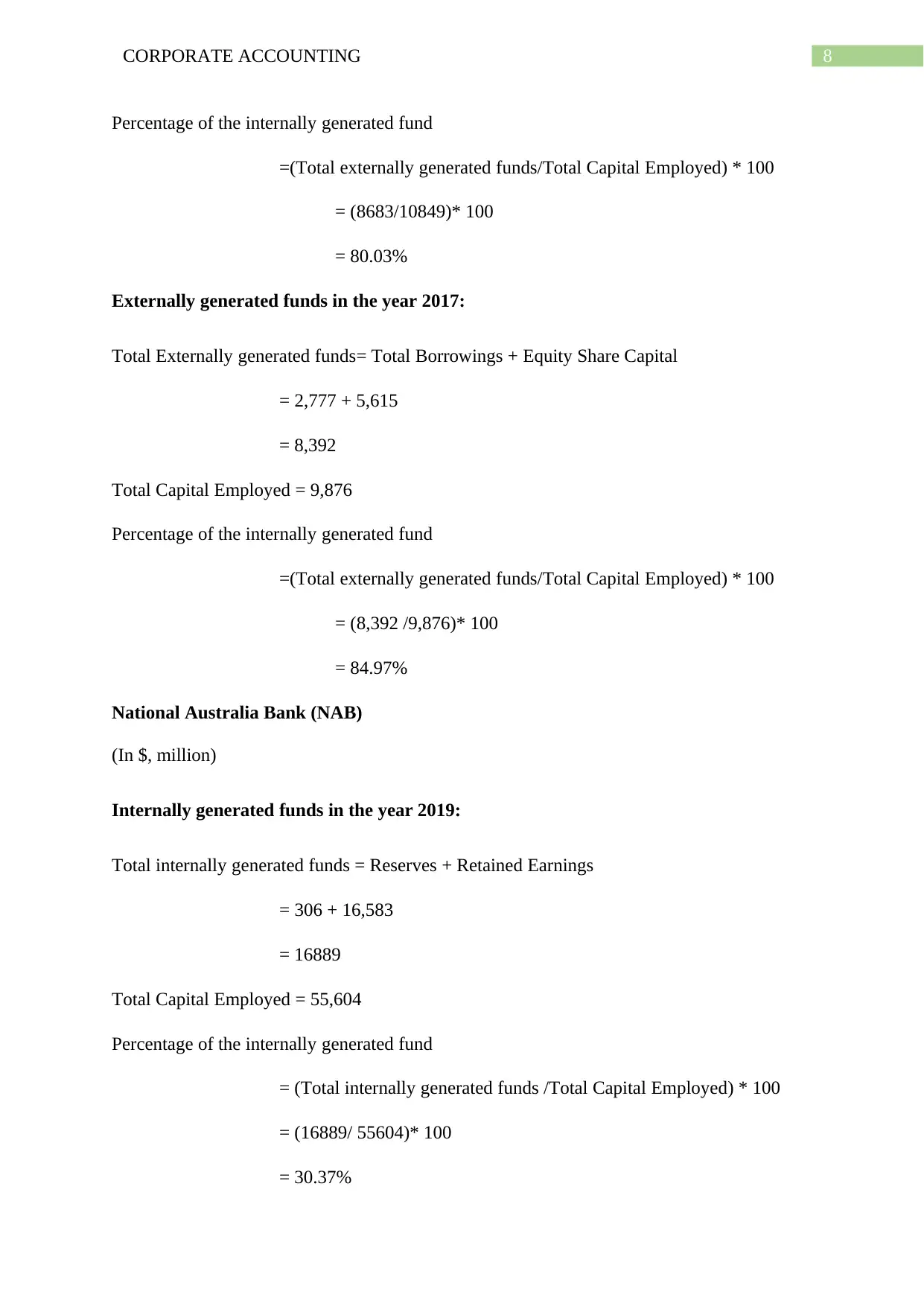
8CORPORATE ACCOUNTING
Percentage of the internally generated fund
=(Total externally generated funds/Total Capital Employed) * 100
= (8683/10849)* 100
= 80.03%
Externally generated funds in the year 2017:
Total Externally generated funds= Total Borrowings + Equity Share Capital
= 2,777 + 5,615
= 8,392
Total Capital Employed = 9,876
Percentage of the internally generated fund
=(Total externally generated funds/Total Capital Employed) * 100
= (8,392 /9,876)* 100
= 84.97%
National Australia Bank (NAB)
(In $, million)
Internally generated funds in the year 2019:
Total internally generated funds = Reserves + Retained Earnings
= 306 + 16,583
= 16889
Total Capital Employed = 55,604
Percentage of the internally generated fund
= (Total internally generated funds /Total Capital Employed) * 100
= (16889/ 55604)* 100
= 30.37%
Percentage of the internally generated fund
=(Total externally generated funds/Total Capital Employed) * 100
= (8683/10849)* 100
= 80.03%
Externally generated funds in the year 2017:
Total Externally generated funds= Total Borrowings + Equity Share Capital
= 2,777 + 5,615
= 8,392
Total Capital Employed = 9,876
Percentage of the internally generated fund
=(Total externally generated funds/Total Capital Employed) * 100
= (8,392 /9,876)* 100
= 84.97%
National Australia Bank (NAB)
(In $, million)
Internally generated funds in the year 2019:
Total internally generated funds = Reserves + Retained Earnings
= 306 + 16,583
= 16889
Total Capital Employed = 55,604
Percentage of the internally generated fund
= (Total internally generated funds /Total Capital Employed) * 100
= (16889/ 55604)* 100
= 30.37%
⊘ This is a preview!⊘
Do you want full access?
Subscribe today to unlock all pages.

Trusted by 1+ million students worldwide
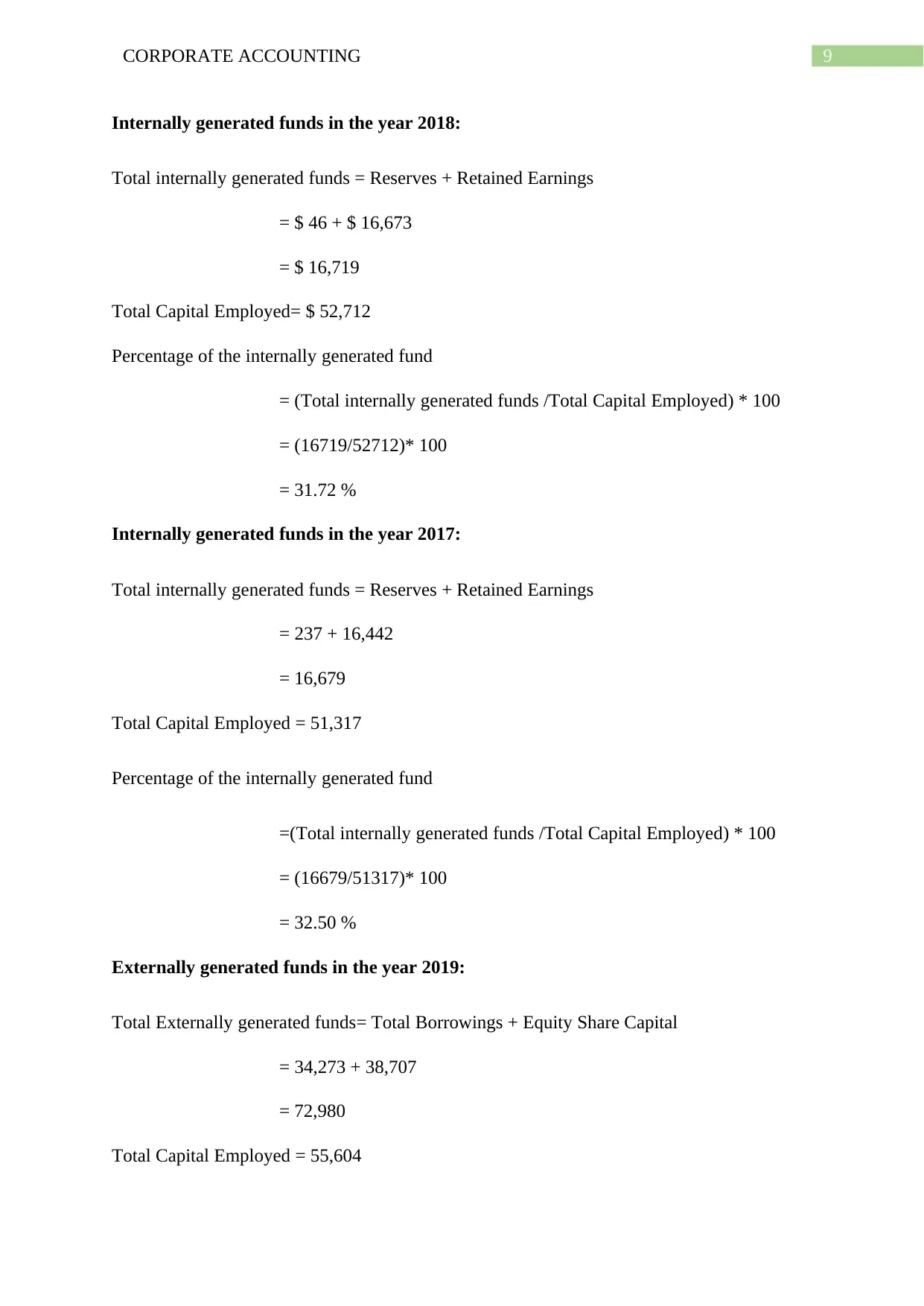
9CORPORATE ACCOUNTING
Internally generated funds in the year 2018:
Total internally generated funds = Reserves + Retained Earnings
= $ 46 + $ 16,673
= $ 16,719
Total Capital Employed= $ 52,712
Percentage of the internally generated fund
= (Total internally generated funds /Total Capital Employed) * 100
= (16719/52712)* 100
= 31.72 %
Internally generated funds in the year 2017:
Total internally generated funds = Reserves + Retained Earnings
= 237 + 16,442
= 16,679
Total Capital Employed = 51,317
Percentage of the internally generated fund
=(Total internally generated funds /Total Capital Employed) * 100
= (16679/51317)* 100
= 32.50 %
Externally generated funds in the year 2019:
Total Externally generated funds= Total Borrowings + Equity Share Capital
= 34,273 + 38,707
= 72,980
Total Capital Employed = 55,604
Internally generated funds in the year 2018:
Total internally generated funds = Reserves + Retained Earnings
= $ 46 + $ 16,673
= $ 16,719
Total Capital Employed= $ 52,712
Percentage of the internally generated fund
= (Total internally generated funds /Total Capital Employed) * 100
= (16719/52712)* 100
= 31.72 %
Internally generated funds in the year 2017:
Total internally generated funds = Reserves + Retained Earnings
= 237 + 16,442
= 16,679
Total Capital Employed = 51,317
Percentage of the internally generated fund
=(Total internally generated funds /Total Capital Employed) * 100
= (16679/51317)* 100
= 32.50 %
Externally generated funds in the year 2019:
Total Externally generated funds= Total Borrowings + Equity Share Capital
= 34,273 + 38,707
= 72,980
Total Capital Employed = 55,604
Paraphrase This Document
Need a fresh take? Get an instant paraphrase of this document with our AI Paraphraser
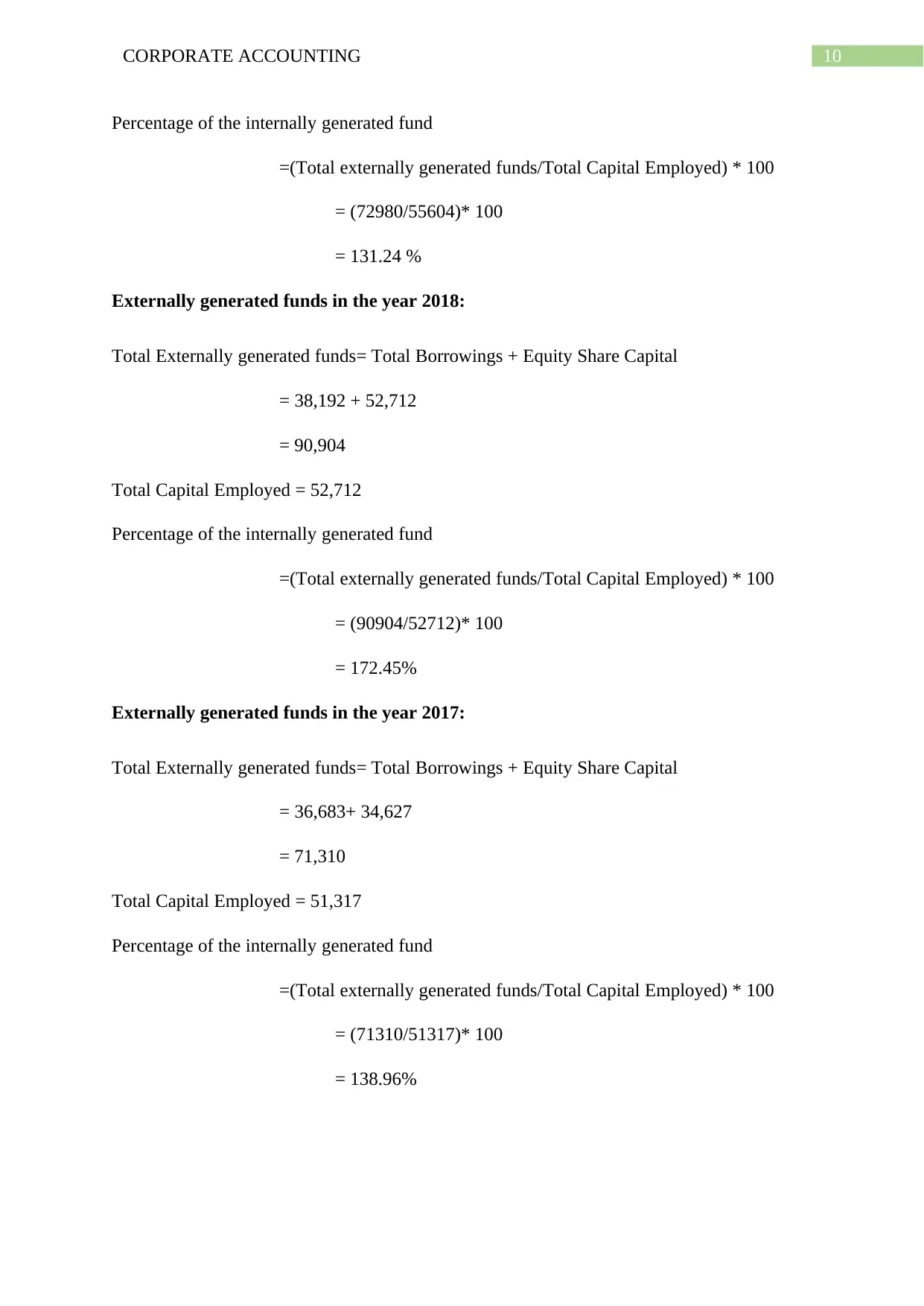
10CORPORATE ACCOUNTING
Percentage of the internally generated fund
=(Total externally generated funds/Total Capital Employed) * 100
= (72980/55604)* 100
= 131.24 %
Externally generated funds in the year 2018:
Total Externally generated funds= Total Borrowings + Equity Share Capital
= 38,192 + 52,712
= 90,904
Total Capital Employed = 52,712
Percentage of the internally generated fund
=(Total externally generated funds/Total Capital Employed) * 100
= (90904/52712)* 100
= 172.45%
Externally generated funds in the year 2017:
Total Externally generated funds= Total Borrowings + Equity Share Capital
= 36,683+ 34,627
= 71,310
Total Capital Employed = 51,317
Percentage of the internally generated fund
=(Total externally generated funds/Total Capital Employed) * 100
= (71310/51317)* 100
= 138.96%
Percentage of the internally generated fund
=(Total externally generated funds/Total Capital Employed) * 100
= (72980/55604)* 100
= 131.24 %
Externally generated funds in the year 2018:
Total Externally generated funds= Total Borrowings + Equity Share Capital
= 38,192 + 52,712
= 90,904
Total Capital Employed = 52,712
Percentage of the internally generated fund
=(Total externally generated funds/Total Capital Employed) * 100
= (90904/52712)* 100
= 172.45%
Externally generated funds in the year 2017:
Total Externally generated funds= Total Borrowings + Equity Share Capital
= 36,683+ 34,627
= 71,310
Total Capital Employed = 51,317
Percentage of the internally generated fund
=(Total externally generated funds/Total Capital Employed) * 100
= (71310/51317)* 100
= 138.96%
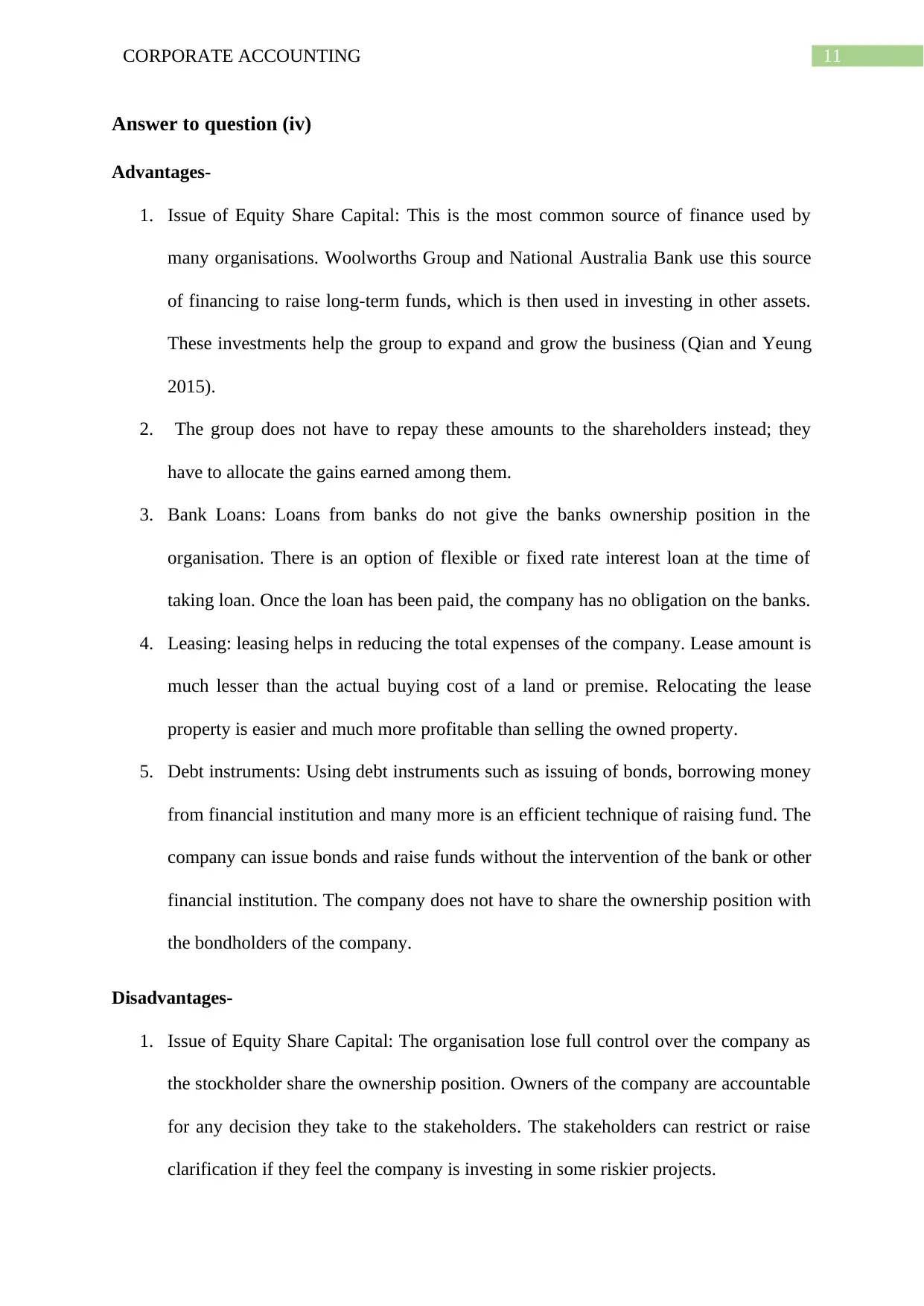
11CORPORATE ACCOUNTING
Answer to question (iv)
Advantages-
1. Issue of Equity Share Capital: This is the most common source of finance used by
many organisations. Woolworths Group and National Australia Bank use this source
of financing to raise long-term funds, which is then used in investing in other assets.
These investments help the group to expand and grow the business (Qian and Yeung
2015).
2. The group does not have to repay these amounts to the shareholders instead; they
have to allocate the gains earned among them.
3. Bank Loans: Loans from banks do not give the banks ownership position in the
organisation. There is an option of flexible or fixed rate interest loan at the time of
taking loan. Once the loan has been paid, the company has no obligation on the banks.
4. Leasing: leasing helps in reducing the total expenses of the company. Lease amount is
much lesser than the actual buying cost of a land or premise. Relocating the lease
property is easier and much more profitable than selling the owned property.
5. Debt instruments: Using debt instruments such as issuing of bonds, borrowing money
from financial institution and many more is an efficient technique of raising fund. The
company can issue bonds and raise funds without the intervention of the bank or other
financial institution. The company does not have to share the ownership position with
the bondholders of the company.
Disadvantages-
1. Issue of Equity Share Capital: The organisation lose full control over the company as
the stockholder share the ownership position. Owners of the company are accountable
for any decision they take to the stakeholders. The stakeholders can restrict or raise
clarification if they feel the company is investing in some riskier projects.
Answer to question (iv)
Advantages-
1. Issue of Equity Share Capital: This is the most common source of finance used by
many organisations. Woolworths Group and National Australia Bank use this source
of financing to raise long-term funds, which is then used in investing in other assets.
These investments help the group to expand and grow the business (Qian and Yeung
2015).
2. The group does not have to repay these amounts to the shareholders instead; they
have to allocate the gains earned among them.
3. Bank Loans: Loans from banks do not give the banks ownership position in the
organisation. There is an option of flexible or fixed rate interest loan at the time of
taking loan. Once the loan has been paid, the company has no obligation on the banks.
4. Leasing: leasing helps in reducing the total expenses of the company. Lease amount is
much lesser than the actual buying cost of a land or premise. Relocating the lease
property is easier and much more profitable than selling the owned property.
5. Debt instruments: Using debt instruments such as issuing of bonds, borrowing money
from financial institution and many more is an efficient technique of raising fund. The
company can issue bonds and raise funds without the intervention of the bank or other
financial institution. The company does not have to share the ownership position with
the bondholders of the company.
Disadvantages-
1. Issue of Equity Share Capital: The organisation lose full control over the company as
the stockholder share the ownership position. Owners of the company are accountable
for any decision they take to the stakeholders. The stakeholders can restrict or raise
clarification if they feel the company is investing in some riskier projects.
⊘ This is a preview!⊘
Do you want full access?
Subscribe today to unlock all pages.

Trusted by 1+ million students worldwide
1 out of 20
Related Documents
Your All-in-One AI-Powered Toolkit for Academic Success.
+13062052269
info@desklib.com
Available 24*7 on WhatsApp / Email
![[object Object]](/_next/static/media/star-bottom.7253800d.svg)
Unlock your academic potential
Copyright © 2020–2025 A2Z Services. All Rights Reserved. Developed and managed by ZUCOL.





